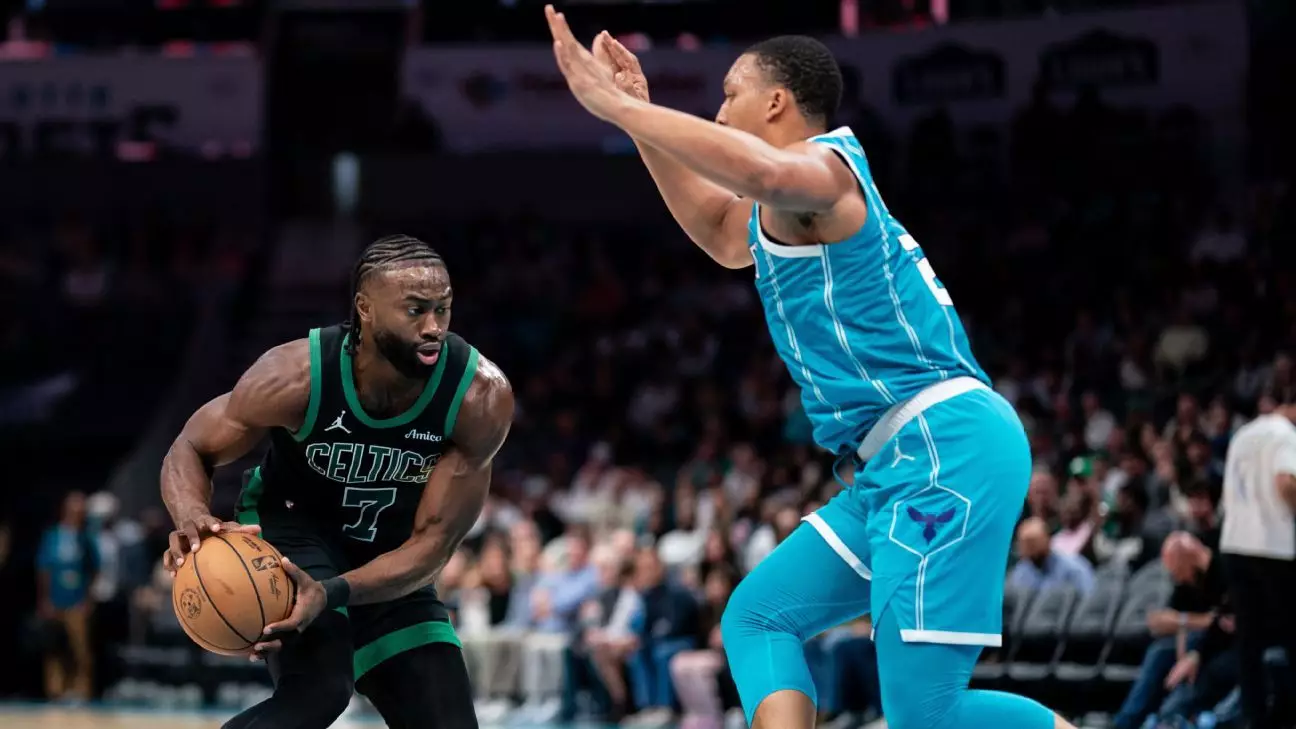The energy of professional basketball often includes moments of brilliance, but sometimes the intensity spills over into contentious encounters off the court. This narrative was palpably evident in the recent game between the Boston Celtics and the Charlotte Hornets, where notable performances were overshadowed by a controversial incident involving Jaylen Brown, Jayson Tatum, and former Celtics teammate Grant Williams. The game highlighted the competitive spirit inherent in the NBA and brought to attention the thin line between aggressive play and sportsmanship.
A Game Dominated by Tension
In the Celtics’ 124-109 victory over the Hornets, Jaylen Brown showcased his impressive skills, contributing 25 points to his team’s success. This performance, however, took a backseat to the events that unfolded as tensions erupted on the court late in the game. As Tatum diligently maneuvered near half court, Williams approached him aggressively, delivering a hard hit that sent Tatum crashing to the ground. This moment became a flashpoint for escalating emotions, leading to Brown vocalizing his disapproval of Williams’ actions.
Brown’s reaction was immediate and intense. He confronted Williams with palpable ire, illustrating not just the physicality of the game, but also the emotional ties that had been frayed by context. The subsequent ejection of Williams for a flagrant foul added fuel to an already ignited atmosphere, suggesting that this game was no longer confined to pure competition. For many fans and observers, it marked a moment where friendship and rivalry collided in an unexpected way.
Brown’s reflections on the incident shed light on the psyche of professional athletes who engage in both strategic gameplay and emotional diplomacy. He dismissed the notion that Williams’ actions were unintentional, challenging the idea of camaraderie that once defined their relationship. “What are we talking about?” Brown pressed, framing the foul in terms that painted Williams as reckless rather than a miscalculation. His metaphor likening the foul to a football hit underscored the seriousness with which he viewed the incident, reinforcing the narrative that certain boundaries should not be crossed, even in competitive sports.
In response, Williams recognized the gravity of his actions but vehemently denied any malicious intent. Claiming that there was no desire to harm one of his closest friends in the league, he emphasized that it was a “hard foul” rather than an intentional attack. This contradiction encapsulated the struggle many athletes face when attempting to balance aggression with friendship. Williams’ comments reveal an understanding of the cultural codes of the NBA, where maintaining a fierce competitive spirit often clashes with the sanctity of personal relationships.
The Aftershocks of the Incident
Following the dramatic escalations, Celtics coach Joe Mazzulla’s reaction was notably composed. By focusing on Tatum’s resilience rather than condemning Williams outright, Mazzulla portrayed a leadership style that prioritized team strength and unity in the face of adversity. The ability of Tatum to rebound quickly after the hit indicated not only his physical capability but also his emotional fortitude, a character trait that Celtics coaches and fans alike admire.
Moreover, the skirmishes did not cease with Williams’ ejection. The game continued to unravel as LaMelo Ball committed another flagrant foul on Tatum, underscoring a night characterized by physical confrontations. This pattern highlighted a mentality that some teams adopt to assert dominance or to rattle their opponents. Brown’s analysis of these tactics reflected on how such altercations can have a larger psychological impact, challenging the psyche of his opponents while cementing team resilience.
With the two teams set to face off again within mere hours of the incident, the anticipation surrounding the matchup heightened. The question lingered: How would the previous night’s exchanges color their next encounter? The NBA is known for its ebb and flow of rivalries and friendships, a complex web that fuels both competition and camaraderie. What transpired on that fateful night was more than just a basketball game; it was a manifestation of the struggles athletes face in managing friendship amid fierce competition.
As the Celtics prepared to host the Hornets again, it became evident that this unfolding drama would not only define the personal trajectories of the involved players but also influence the dynamic of future encounters in the league. The sport continues to thrive on these narratives, a reminder that in basketball, as in life, the stakes are rarely simply about the score on the board.


Leave a Reply